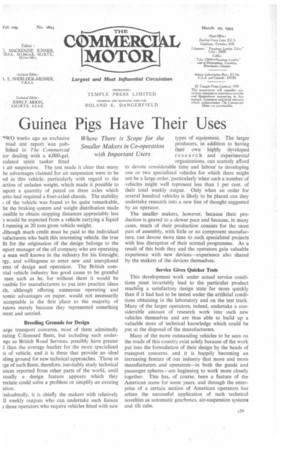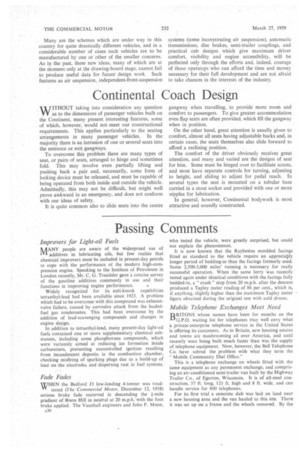Guinea Pigs Have Their Uses
Page 31

Page 32

If you've noticed an error in this article please click here to report it so we can fix it.
"M/0 Weeks ago an exclusive road test report was published in The Commercial tor dealing with a 4,000-gal. culated spirit tanker fitted 3. air suspension. The test made it clear that many he advantages claimed for air suspension were to be rid in this vehicle, particularly with regard to the action of unladen weight, which made it possible to isport a quantity of petrol on three axles which ierto had required a four-axled chassis. The stability of the vehicle was found to be quite remarkable, 1st the braking system and weight distribution made ossible to obtain stopping distances appreciably less 3 would be expected from a vehicle carrying a liquid I running at 20 tons gross vehicle weight.
dthough much credit must be paid to the individual tufacturers who built this interesting vehicle, the true lit for the origination of the design belongs to the [sport manager of the oil company who are operating a man well known in the industry for his foresight, rgy, and willingness to enter new and unexplored eres of design and operation. The British corntial vehicle industry has good cause to be grateful men such as he, for without them it would be iossible for manufacturers to put into practice ideas ch, although offering numerous operating and lomic advantages on paper, would not necessarily acceptable in the first place to the majority of rators merely because they represented something rent and untried.
Breeding Grounds for Design arge transport concerns, most of them admittedly rating C-licensed fleets, but including such underrigs as British Road Services, possibly have greater I than the average haulier for the more specialized :s of vehicle, and it is these that provide an ideal :ding ground for new technical approaches. Those in rge of such fleets, therefore, inevitably study technical ances reported from other parts of the world, until nually a design feature appears which they reciate could solve a problem or simplify an existing ation, rndoubtedly, it is chiefly the makers with relatively II weekly outputs who can undertake such liaison those operators who require vehicles fitted with new types of equipment. The larger producers, in addition to having their ,own highly developed research and experimental organizations, can scarcely afford to devote considerable time and labour to developing one or two specialized vehicles for which there might not be a large order, particularly when such a number of vehicles might well represent less than 1 per cent, of their total weekly output. Only when an order for several hundred vehicles is likely to be Placed can they undertake research into a new line of thought suggested by an operator.
The smaller makers, however, because their production is geared to a slower pace and because, in many cases, much of their production consists for the most part of assembly, with little or no component manufacture, can devote more time to such specialized projects with less disruption of their normal programme. As a result of this both they and the operators gain valuable experience with new devices—experience also shared by the makers of the devices themselves, Service Gives Quicker Tests This development work under actual service conditions must invariably lead to the particular product reaching a satisfactory design state far more quickly than if it had had to be tested under the artificial conditions obtaining in the laboratory and on the test track. Many of the larger operators, indeed, undertake a considerable amount of research work into such new vehicles themselves and are thus able to build up a valuable store of technical knowledge which could be put at the disposal of the manufacturers.
Many of the more outstanding vehicles to be seen on the roads of this country exist solely because of the work put into the formulation of their design by the heads of transport concerns, and it is happily becoming an increasing feature of our industry that more and more manufacturers and operators—in both the goods and passenger spheres—are beginning to work more closely together. This has, of course, been a feature of the American scene for some years, and through the enterprise of a certain section of American operators. has arisen the successful application of such technical novelties as automatic gearboxes, air-suspension systems and tilt cabs. Many are the schemes which are under way in this country for quite drastically different vehicles, and in a considerable number of cases such vehicles are to be manufactured by one or other of the smaller concerns. As in the past, these new ideas, many of which are at the moment only at the drawing-board stage. cannot fail to produce useful data for future design work. Such features as air suspension, independent-front-suspension systems (some incorporating air suspension), automatic transmissions, disc brakes, semi-trailer couplings, and practical cab designs which give maximum driver comfort, visibility and engine accessibility, will be perfected only through the efforts and, indeed, courage of those operators who can afford the time and money necessary for their full development and are not afraid to take chances in the interests of the industry.




































































































